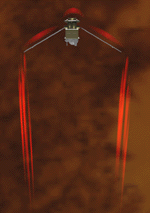![]()
![]()
 |
After the MOI burn, Surveyor will whirl around Mars once every 48 hours in a highly elliptical orbit with high point of 56,000 kilometers (34,800 miles) and a low point of 300 kilometers (186 miles). Before mapping operations can begin, the flight team must find a way to lower the orbit's high point to an altitude near 400 kilometers (250 miles).
The traditional method of lowering a highly elliptical orbit involves using the rocket engine to slow the spacecraft at the orbit's low point. In the business of orbital mechanics, if a spacecraft slows down at the low point in the orbit, the next pass through the high point will be at a lower altitude. Unfortunately, the small Delta-7925 rocket that launched Surveyor from Earth lacks the punch needed to lift both the spacecraft and the propellant needed to slow down in Mars orbit.
Fortunately, the mission design engineers at the Jet Propulsion Laboratory have developed an innovative technique to lower the orbit without using Surveyor's rocket engine. They call this new idea "aerobraking." Essentially, the solution works in the same way that children slow down and lower how high they swing on a playground swingset by dragging their feet through the sand as they swing pass the bottom.
In order to begin the aerobraking process, the flight team will command the spacecraft to lower the low point of its orbit into the upper fringes of the Martian atmosphere.During every subsequent pass through the orbit's low point, Surveyor will encounter air resistance and will slow slightly. Consequently, the spacecraft will not climb as high on its next pass through the orbit's high point.
Safety Margins. Initial calculations show that the low point of Surveyor's orbit must lie in a corridor between 105 kilometers (65 miles) and 110 kilometers (68 miles) above the Martian surface. If the spacecraft flies lower, it will encounter too much air resistance and burn up like a shooting star. Conversely, if the spacecraft flies higher, it will not encounter enough air resistance to slow down appreciably.
Despite all of the pre-planning, the flight team will need to make rapid, minor adjustments to the spacecraft's orbit to successfully carry out aerobraking. The main problem is that scientists only have a limited amount of knowledge regarding the thickness of the air in the upper Martian atmosphere. Because the air thickness will determine the exact altitude of the safety corridor, the flight team will need to alter the orbit's low point if Martian weather conditions alter the conditions in the atmosphere.
Aerobraking will take until mid-January 1998 to complete. At that time, the orbit will lie at the correct altitude for mapping operations, but not in the correct geometrical orientation. Over the next two months, small irregularities in the shape of Mars and its gravitational pull will automatically nudge Surveyor's orbit into the correct geometrical orientation.